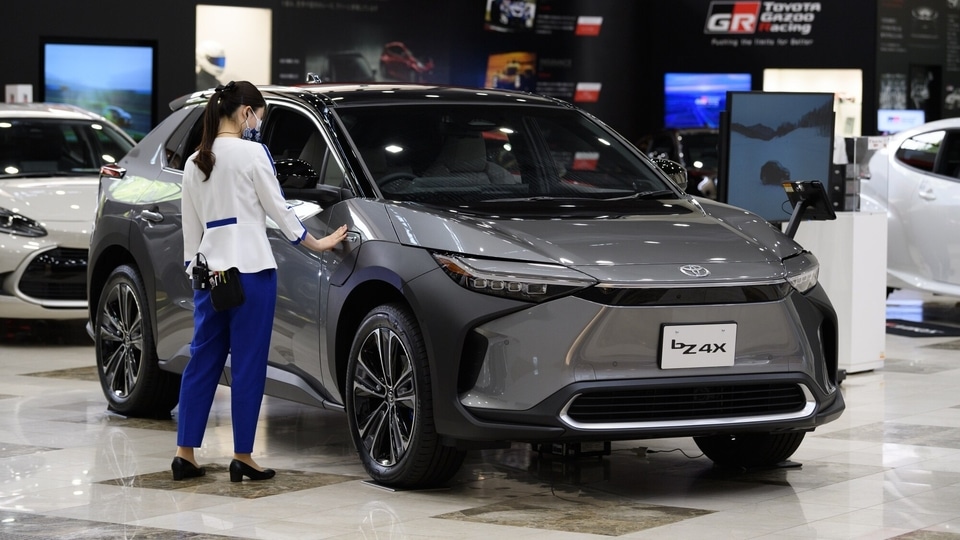Toyota May Yet Do a Tesla and Upend EVs
The automaker’s claim of a breakthrough on one of the holy grails of electric vehicles — solid-state batteries — has the potential to transform the industry.


Toyota Motor Corp. is doing its part for the Japan comeback story. The automaker claims it has made a breakthrough on one of the holy grails of electric vehicles: solid-state lithium ion batteries, which promise much longer range and better safety than current technology. Like Japan itself, the country's most-valuable company could use a revival. Long a byword for manufacturing excellence plus, not so long ago, a darling of green activists for its hybrid Prius cars, Toyota is now seen as having missed out on the EV revolution pioneered by upstarts like Tesla Inc. Cracking the code on the next generation of EV batteries could silence the naysayers about both Toyota and its home country.
It could also upend the EV business even as that business is itself upending the wider autos industry.
With the caveat that any claim about commercializing solid-state batteries must automatically be met with an “uh huh,” think about what a breakthrough along the lines of Toyota's claims would mean: A battery that can power a vehicle for 745 miles on a single charge, recharge in 10 minutes or less and is far less prone to overheating and fire. In other words, all the current hang-ups about EVs — range, refueling time, safety — disappear. Even a Prius doesn't go that far on a single tank.
This would represent transformational change in an autos industry that tends to advance by increment. Traditional vehicles with internal combustion engines don't compete on range; fuel economy and horsepower are their battlegrounds, in a war of accretion. The average new model 2022 vehicle sold in the US was 12% more efficient than a decade before and just over 100% more efficient than a 1975 model — in part because horsepower came back into fashion, along with heavier trucks, once the oil shocks were a distant memory.
The most interesting advances in traditional motor vehicles so far this century have been digital rather than mechanical. Integration with the Internet and wireless communications changed how we buy, maintain and, with the advent of ride-sharing, use or monetize vehicles. The same goes with how we entertain ourselves (much to the regret of AM radio aficionados). Advances in computing power, sensors and cameras and artificial intelligence have also made driver-assistance features reasonably ubiquitous, even if automated driving remains an overhyped technology of the future. These are, in the main, experiential tweaks rather than profound upgrades to fundamental characteristics, in keeping with an industry that tends to compete heavily on variants of core models rather than brand new marques. Consider: There are dozens of sub-model and trim levels of America's best-selling vehicle, the Ford F-150 pickup. And that's before you start picking your paint.
Toyota's claim reminds us that, in the relatively nascent world of EVs, the potential for truly radical upgrades is strong — and claims such as this one should spur competitive spirits across the sector. Indeed, a fully electrified future for passenger vehicles may well depend on such breakthroughs, especially in a market like the US where power-hungry trucks and SUVs dominate. In all likelihood, even commercialized solid-state batteries would enter the market in higher-priced vehicles first and then disseminate down the chain as scale economies kick in. But things can move fast in EV land: An average lithium-ion battery pack in 2022 was 88% cheaper than in 2010, the year Tesla went public.
The appearance of radically higher-performance EVs at even a mass-affluent price level would send shockwaves through the market.
For existing EV owners it would pose pluses and minuses. On one hand, the next EV they buy could offer far greater range and charging speed. On the other, our existing EVs would suddenly look like maybe-not-quite dinosaurs but at least like early mammals not destined to thrive under Darwinism. My own EV has a range of about 300 miles which is, for my family's purposes, more than adequate; in the past nine months of ownership, we have needed to use a public fast-charger precisely once, and it was a seamless 30-minute experience. I doubt I would feel the need to immediately upgrade to a vehicle offering double the range or more from a practical or emotional standpoint.
On the other hand, I might feel nervous from a financial perspective. The battery is the single biggest cost in an EV and, by extension, a major determinant of resale value for used EVs. As it stands, gauging resale trends for EVs is complicated by the fact that there aren't that many used vehicles out there and Teslas dominate, skewing a small market toward a brand with peculiarly intense loyalty. In Kelley Blue Book's latest ranking of resale values, for example, Tesla's high-end Model X SUV is the only one to make the overall top 10, retaining 66% of its value after five years, on average. Other, more mass-market models like Ford's Mustang Mach-E or General Motors Co.'s Chevy Bolt — the latter soon to be discontinued — come in at more like 41%. Again, though, the sample size is exceedingly small.
It is fair to say, however, that even if a battery that will take you 300 miles degrades only a little over five years and, therefore, remains adequate for most uses, the arrival of batteries that can go twice as far, and more safely, will degrade that older version's value significantly. We have seen before how sudden shifts in market conditions can inflict damage on used car pricing. Gas-guzzling trucks and SUVs — Detroit's mainstay — took a big hit in 2009 after the run-up in oil prices to their 2008 peak. Conversely, whereas Toyota sold almost a quarter of a million Priuses in the US in 2013, the last year when oil averaged more than $100 a barrel, the resurgence of trucks and rise of true EVs pushed sales to less than 40,000 last year. Meanwhile, this year, both new and used EV prices tumbled as Tesla engaged in a price war.
Apart from early adopters, this poses a conundrum for manufacturers' leasing arms. The risks today are limited by the small pool of vehicles, with only about 2.5 million battery EVs on the road in the US, and only a portion of those leased. By 2027, though, the year Toyota's solid-state batteries may be ready for use in EVs, there could be 17 million battery EVs out there, according to Bloomberg NEF forecasts, meaning a sizeable number of leases exposed to any sudden shift in battery technology and, therefore, residual value.
Yet the leasing arm's complications may be the least of manufacturers' concerns. The potential for battery breakthroughs mean even a relative laggard like Toyota today could suddenly become a leader down the road. Toyota's weak performance in EVs to date counts against it and, in that light, makes its solid-state claims look like a desperate attempt to claw back relevancy in a fast-growing part of the market. History is littered with giant incumbents who fail in the face of disruption.
Equally, to dismiss Toyota, which revolutionized vehicle manufacturing and remains the biggest by unit sales worldwide, would be foolish. So much of the conversation about the future of vehicles centers on achieving true self-driving, which finds its financial apotheosis in the inflated valuation of Tesla. Yet it seems at least as likely that we will see a breakthrough in chemistry before autonomy. Tesla is also potentially well-positioned on that front, but the battery supply chain is more diffuse, leaving more lanes open for someone else to pull ahead.
We are not used to profound change in a century-old autos industry, which is how Tesla and EVs upended things already. But electrified transport's inherent capacity for further leaps means we shouldn't assume this new normal will remain so.
Liam Denning is a Bloomberg Opinion columnist covering energy and commodities. A former investment banker, he was editor of the Wall Street Journal's Heard on the Street column and a reporter for the Financial Times's Lex column.
Catch all the Latest Tech News, Mobile News, Laptop News, Gaming news, Wearables News , How To News, also keep up with us on Whatsapp channel,Twitter, Facebook, Google News, and Instagram. For our latest videos, subscribe to our YouTube channel.

























